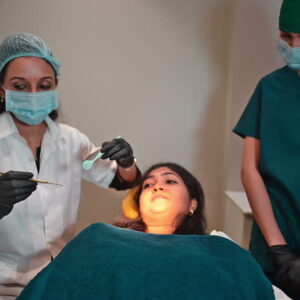A semi-adjustable articulator is a fundamental tool in dentistry, which provides accurate replication of jaw movements and positioning. They have a fixed intercondylar distance and adjustable condylar guidance, and lateral side shift adjustable. The utilization of this device has proved to be extremely advantageous in the reproduction of both static and dynamic maxillo-mandibular positions. It is a complex device that offers many features that contribute to the precision of dental restorations.

Features
- One of the most important features of a semi-adjustable articulator is the average value feature. This feature allows the average position of the mandible to be set and adjusted according to the patient’s needs. The average value feature provides a great deal of flexibility in adjusting the articulator, which leads to more precise dental restorations.
- Another essential feature of a semi-adjustable articulator is the facebow transfer. The facebow transfer is a device that records the relationship between the patient’s maxillary arch and the hinge axis of the mandible. It provides accurate mounting of the maxillary cast on the articulator. The facebow transfer is a crucial element in dental restorations because it ensures precise articulation of the models on the articulator.
- Many semi-adjustable articulators also come with a magnetic base. The magnetic base provides a secure and stable platform for the articulator during use. It makes it easy to work with the articulator, which ensures that it stays securely in place during use. The magnetic base is an essential feature because it contributes to the accuracy of dental restorations.
- Adjustable Incisal Guide Table: The incisal guide table is used to set the vertical dimension of the occlusion. A semi-adjustable articulator allows the dentist to adjust the incisal guide table to match the patient’s occlusal plane, ensuring that the restoration fits properly and functions correctly.
- Calibration is an important aspect of using a semi-adjustable articulator. Calibration ensures that the articulator is accurately replicating the patient’s movements. Regular calibration is necessary to maintain the accuracy of the articulator and to ensure the creation of precise dental restorations. The calibration process is critical because it ensures that the articulator maintains its accuracy and provides the best possible results for patients.
The model can be easily switched from one articulator to another with complete assurance that the calibration will remain consistent. This not only eliminates the need for transporting the articulator back and forth but also eliminates the stress that can be placed on it during transport. This feature not only ensures accurate registration and simulation but also saves time and effort for the user. With this level of precision and convenience, the articulator can be used with confidence for a wide variety of dental procedures.
Difference between semi-adjustable and fully-adjustable articulator
Semi-adjustable articulators have a fixed condylar path angle, which is set at an average value of 30 degrees. This means that the condylar path angle cannot be adjusted to match the specific patient’s anatomy, which can lead to inaccuracies in dental restorations. On the other hand, fully-adjustable articulators have an adjustable condylar path angle, which can be set to match the patient’s specific anatomy, leading to greater accuracy in dental restorations.


Fully-adjustable articulators also have additional features that semi-adjustable articulators do not have, such as adjustable inclination, adjustable Bennett angle, and adjustable protrusive guides. These features allow for a greater degree of accuracy in dental restorations and are especially useful in complex cases.
Overall, while semi-adjustable articulators have many valuable features, they are limited by their fixed condylar path angle. Fully-adjustable articulators offer greater flexibility and accuracy in dental restorations, making them a preferred choice for many dental professionals, especially in complex cases.
Dental Lab Shop provides a semi-adjustable Artex system-compatible articulator
Semi-adjustable articulators are also often compatible with the Artex system. The Artex system is a widely used system for dental articulation. Compatibility with the Artex system allows for greater flexibility and accuracy in the dental laboratory. It provides a great deal of versatility in the creation of dental restorations.
A semi-adjustable articulator is a valuable tool in dentistry, and its features contribute to the precision of dental restorations. The average value feature, facebow transfer, magnetic base, and compatibility with the Artex system make it a versatile and essential tool in the dental laboratory. Regular calibration ensures that the articulator maintains its accuracy, which provides the best possible results for patients. The semi-adjustable articulator is a complex device, but it is an essential component of the dental laboratory, which contributes to the quality of dental restorations.
If you’re looking for a reliable and versatile semi-adjustable articulator, Dental Lab Shop has got you covered! Our articulators are compatible with the Artex system and come with a face bow transfer for greater accuracy in dental restorations. Plus, with FedEx or DHL Express worldwide tracking shipping and easy Artex mounting, you can start using your new semi-adjustable articulator in no time!





